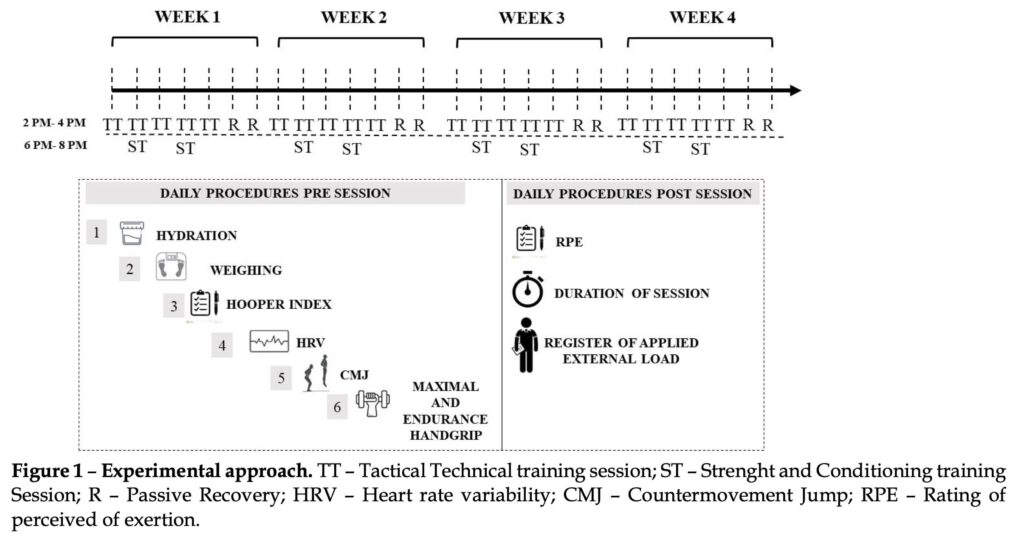Monitoring Training Loads in Judo Athletes

ABSTRACT
This study aims to elucidate the internal load, performance, physiological, and perceptual recovery responses during four weeks of traditional judo training. Ten cadet and junior judo athletes were evaluated daily for four weeks, in which their perception of recovery, heart rate variability, handgrip strength, and countermovement jump performance were assessed. A one-way repeated- measures ANOVA was performed to analyze the variables across the weeks. A significant time effect in internal load (F = 6.51; p = 0.001) has been observed. Handgrip test performance showed significantly higher values in the 3rd and 4th weeks (p <0.001), while countermovement jump performance was significantly higher in the 4th week (p =0.0007). The heart rate variability`s coefficient of variation was lower in both the 3rd and 4th weeks (p =0.02). Regarding perceptual aspects, the Hooper Index showed a significant time effect (p =0.04), but pairwise comparison did not reveal differences between weeks. The present study indicates that neuromuscular, physiological, and perceptual responses to training load alterations present different time courses. This must be considered for the
adequate monitoring of training programs.
KEY WORDS: Recovery, heart rate variability, muscle power

Download the full article HERE.


I want to see more of this from you! And I am going to link back to this post right now.
Thanks!
I could not resist commenting. Very well written!
Some genuinely interesting details you have written.Helped me
a lot, just what I was looking for :D.
Pingback: buy albino penis envy penis envy shrooms magic mushroom tea for sale microdose mushroom alacabenzi-mushroom-strain microdose-focus great-white-monster-magic-mushrooms microdose-mellow blue-meanies-magic-mushrooms mushroom-compost-for-sale magic mushrooms
Pingback: bunnies-for-sale
Pingback: รับทำเว็บไซต์
Pingback: sahabatqq login
I’m really enjoying the design and layout of your site. It’s a
very easy on the eyes which makes it much more pleasant for me to come here and visit
more often. Did you hire out a designer to create your theme?
Exceptional work!
This actually answered my drawback, thanks!
Pingback: Relating to Gold IRA Regulations - Jsg24 News
I got this site from my friend who informed me concerning
this web site and now this time I am browsing this web site and reading very informative articles or reviews here.
Look at my webpage :: vpn special
It’s very easy to find out any topic on web as compared to books, as I found this piece of writing at this site.
Look into my blog post … vpn special
Pingback: Trustbet
I and my pals were actually looking through the best tactics found on the blog then all of the sudden came up with a terrible suspicion I never thanked you for those secrets. My ladies had been as a result warmed to read through them and already have very much been making the most of those things. Many thanks for turning out to be simply thoughtful and for settling on variety of incredibly good themes most people are really desperate to learn about. My very own sincere apologies for not expressing gratitude to earlier.
I like the valuable information you provide in your articles. I will bookmark your weblog and check again here regularly. I’m quite sure I will learn many new stuff right here! Good luck for the next!
Nice post. I used to be checking constantly this
blog and I am impressed! Very helpful info specially the remaining
phase 🙂 I handle such information a lot. I used facebook vs eharmony to find love online be looking for this particular information for a very lengthy time.
Thanks and good luck.
Hello! Would you mind if I share your blog with my twitter group?
There’s a lot of people that I think would really enjoy your content.
Please let me know. Many thanks
Check out my web site :: eharmony special coupon code 2024
Pingback: hfm ดีไหม
I read this paragraph completely concerning the difference
of most recent and preceding technologies, it’s amazing
article.
Also visit my website – nordvpn special coupon code 2024
Pingback: iTune gift card
Pingback: รวมเว็บพนันออนไลน์
Thanks for giving your ideas. The one thing is that pupils have an alternative between federal government student loan along with a private education loan where its easier to opt for student loan online debt consolidation than through the federal student loan.
This is very interesting, You are a very skilled blogger. I have joined your rss feed and look forward to seeking more of your excellent post. Also, I’ve shared your site in my social networks!
I additionally believe that mesothelioma cancer is a rare form of cancer malignancy that is normally found in these previously familiar with asbestos. Cancerous cellular material form inside the mesothelium, which is a defensive lining that covers the vast majority of body’s areas. These cells typically form while in the lining of your lungs, abdomen, or the sac that encircles the heart. Thanks for discussing your ideas.
I figured out more something totally new on this losing weight issue. Just one issue is a good nutrition is extremely vital if dieting. An enormous reduction in fast foods, sugary food items, fried foods, sugary foods, pork, and white-colored flour products can be necessary. Possessing wastes parasitic organisms, and harmful toxins may prevent aims for losing weight. While a number of drugs temporarily solve the condition, the horrible side effects are not worth it, and they never provide more than a short-lived solution. It is a known fact that 95 of fad diets fail. Many thanks for sharing your opinions on this site.
Pingback: เว็บพนันออนไลน์อย่าง HYDRA 888 ดีไหม ?
Good article. It is extremely unfortunate that over the last several years, the travel industry has had to fight terrorism, SARS, tsunamis, bird flu, swine flu, and the first ever true global tough economy. Through everything the industry has really proven to be effective, resilient and dynamic, getting new ways to deal with adversity. There are generally fresh challenges and opportunities to which the business must again adapt and act in response.
pin up casino azerbaycan https://azerbaijancuisine.com/# pin-up 141
pin-up
Today, considering the fast chosen lifestyle that everyone leads, credit cards have a big demand in the economy. Persons out of every area are using the credit card and people who aren’t using the card have lined up to apply for one. Thanks for discussing your ideas on credit cards.
medication from mexico pharmacy mexican pharmacy online best online pharmacies in mexico
mexican drugstore online mexican northern doctors medicine in mexico pharmacies
buying from online mexican pharmacy Mexico pharmacy that ship to usa buying from online mexican pharmacy
mexican rx online mexican pharmacy online medication from mexico pharmacy
https://northern-doctors.org/# best online pharmacies in mexico
http://northern-doctors.org/# reputable mexican pharmacies online
Pingback: เว็บปั้มไลค์
pharmacies in mexico that ship to usa mexican pharmacy online mexico drug stores pharmacies
https://northern-doctors.org/# reputable mexican pharmacies online
pharmacies in mexico that ship to usa: Mexico pharmacy that ship to usa – mexican pharmacy
https://northern-doctors.org/# mexico pharmacy
https://northern-doctors.org/# purple pharmacy mexico price list
п»їbest mexican online pharmacies medicine in mexico pharmacies mexican rx online
https://northern-doctors.org/# buying prescription drugs in mexico online
https://northern-doctors.org/# mexican rx online
mexico pharmacies prescription drugs: northern doctors – mexican rx online
http://northern-doctors.org/# buying from online mexican pharmacy
https://northern-doctors.org/# mexican border pharmacies shipping to usa
buying prescription drugs in mexico mexican pharmacy п»їbest mexican online pharmacies
Thanks for your advice on this blog. 1 thing I would like to say is that often purchasing electronics items through the Internet is nothing new. The fact is, in the past several years alone, the market for online consumer electronics has grown substantially. Today, you will find practically any kind of electronic gizmo and other gadgets on the Internet, ranging from cameras plus camcorders to computer pieces and gambling consoles.
purple pharmacy mexico price list: mexican pharmacy online – mexico pharmacy
https://northern-doctors.org/# mexican rx online
mexico pharmacy: mexican pharmacy online – purple pharmacy mexico price list
https://northern-doctors.org/# п»їbest mexican online pharmacies
https://northern-doctors.org/# mexico drug stores pharmacies
medicine in mexico pharmacies northern doctors pharmacy mexican drugstore online
п»їbest mexican online pharmacies online mexican pharmacy pharmacies in mexico that ship to usa
buying from online mexican pharmacy: mexico pharmacy – mexican mail order pharmacies
mexican rx online mexican pharmacy online mexican pharmacy
mexican border pharmacies shipping to usa cmqpharma.com mexican drugstore online
mexican border pharmacies shipping to usa mexican pharmacy mexico pharmacy
mexico pharmacy mexican pharmacy medicine in mexico pharmacies
I used to be suggested this web site by my cousin. I’m not sure whether or not this submit is written through him as nobody else understand such certain approximately my problem. You are amazing! Thanks!
I haven抰 checked in here for some time as I thought it was getting boring, but the last several posts are good quality so I guess I抣l add you back to my daily bloglist. You deserve it my friend 🙂
mexican border pharmacies shipping to usa cmq pharma purple pharmacy mexico price list
mexican mail order pharmacies
https://cmqpharma.com/# buying prescription drugs in mexico online
buying prescription drugs in mexico online
mexican border pharmacies shipping to usa mexican online pharmacy mexican online pharmacies prescription drugs
mexican drugstore online cmq pharma mexican pharmacy medication from mexico pharmacy
buying prescription drugs in mexico mexican pharmacy online mexico drug stores pharmacies
great points altogether, you simply gained a brand new reader. What would you suggest in regards to your post that you made a few days ago? Any positive?
mexican rx online: mexico pharmacy – purple pharmacy mexico price list
Very good information can be found on website.Raise your business
reputable mexican pharmacies online: mexican mail order pharmacies – mexican pharmaceuticals online
https://foruspharma.com/# purple pharmacy mexico price list
is canadian pharmacy legit online pharmacy canada canadian pharmacy mall
Online medicine order: world pharmacy india – buy prescription drugs from india
ordering drugs from canada: canadian pharmacy 24h com – vipps approved canadian online pharmacy
indian pharmacy online: india pharmacy mail order – mail order pharmacy india
buying from online mexican pharmacy: mexican drugstore online – п»їbest mexican online pharmacies
https://canadapharmast.com/# reliable canadian pharmacy reviews
indian pharmacies safe: top 10 online pharmacy in india – indian pharmacy
mexican rx online: buying prescription drugs in mexico – mexican online pharmacies prescription drugs
buy medicines online in india reputable indian pharmacies best online pharmacy india
canada rx pharmacy: precription drugs from canada – global pharmacy canada
mexico drug stores pharmacies: medication from mexico pharmacy – medicine in mexico pharmacies
indian pharmacies safe: indian pharmacy – indianpharmacy com
india pharmacy: online shopping pharmacy india – mail order pharmacy india
http://clomiddelivery.pro/# where can i get cheap clomid price
http://ciprodelivery.pro/# buy cipro
http://ciprodelivery.pro/# where can i buy cipro online
http://doxycyclinedelivery.pro/# order doxycycline online uk
http://ciprodelivery.pro/# ciprofloxacin 500 mg tablet price
https://paxloviddelivery.pro/# Paxlovid buy online
https://doxycyclinedelivery.pro/# doxycycline acne
https://ciprodelivery.pro/# buy ciprofloxacin over the counter
https://amoxildelivery.pro/# amoxicillin online canada